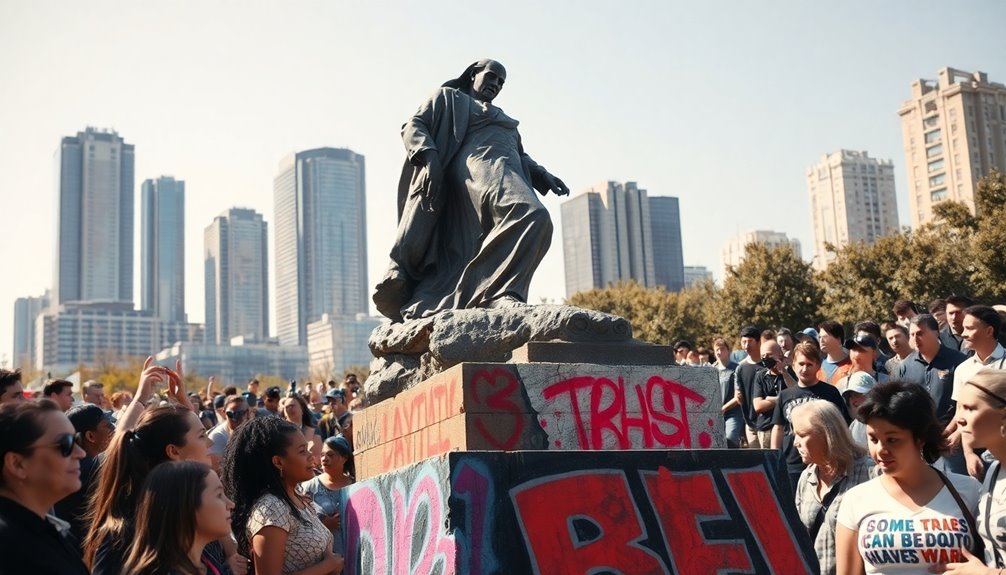When a bust goes sideways, you can expect chaos, heightened violence, and major legal headaches for police agencies. Insufficient planning or miscommunication often fuels these failures, increasing the risk of violent confrontations and public outrage. Legal repercussions like costly lawsuits erode community trust, adding to the stress officers face during operations. High-profile incidents, like the 2006 New Orleans raid, show how misinformation can derail intended outcomes, leading to intense scrutiny and calls for accountability. Understanding these factors is essential for improving future operations and rebuilding community relationships, so stick around to explore how these dynamics unfold.
Understanding the Bust Concept
A bust is fundamentally a high-stakes police operation aimed at catching criminals involved in illegal activities like drug trafficking or organized crime. You might think of a bust as the culmination of meticulous planning, where law enforcement officials gather intelligence to guarantee a successful outcome. Sustainable delivery practices can also enhance the effectiveness of operations by ensuring resources are used efficiently. Additionally, employing clear payment terms in financial dealings can help streamline operational costs.
However, when you dig deeper into the concept, you realize that a bust can easily go sideways. Insufficient intelligence or miscommunication among teams can lead to unexpected complications. Imagine officers arriving at a location without a clear understanding of the situation—this can result in chaos. Prioritizing sustainable options during planning can help mitigate some of these risks.
The presence of armed individuals adds another layer of risk, making it vital for officers to maintain composure and follow a well-thought-out strategy. The lessons learned from historical busts underscore the need for proper planning, intelligence gathering, and rigorous officer training. Moreover, leveraging accurate categorization in real-time can enhance decision-making during such operations.
When these elements align, a bust can effectively disrupt criminal activities. But if they don't, you could witness a failed bust, which can have serious consequences for all involved. Understanding the bust concept means recognizing both its potential and its pitfalls, highlighting the importance of preparation in high-stakes scenarios.
Consequences of Failed Operations
When a bust goes wrong, the aftermath can be severe and far-reaching. Failed busts often lead to significant legal repercussions for law enforcement agencies, including costly lawsuits and increased scrutiny from governing bodies.
You might notice that community trust in the police takes a major hit, creating long-lasting negative relationships between officers and the public. This erosion of trust can make future operations more challenging, as cooperation from community members diminishes. Furthermore, the use of budget apps can help police departments manage their resources more effectively and mitigate the financial impact of such failures. In fact, apps like YNAB provide tools for prioritizing spending and can empower departments to take control of their financial health.
Moreover, high-profile failed busts attract intense media scrutiny. Sensationalized reporting can distort the public's perception of law enforcement practices, making it harder for officers to maintain credibility.
The potential for violence or injury also escalates during poorly executed operations, placing both officers and civilians at unnecessary risk. Budget apps can provide insights into spending habits, enabling departments to allocate funds strategically and avoid overspending on operations.
Financially, municipalities can feel the pinch from failed busts, facing substantial settlements and legal fees that strain budgets. This can divert resources from essential services that communities rely on, exacerbating tensions.
Ultimately, the consequences of failed operations extend far beyond the immediate incident, affecting everything from community relations to financial stability. These failures can also hinder the effectiveness of expense management apps, which are crucial for maintaining budgetary control in police departments.
Factors Behind Bust Failures

When a bust goes sideways, poor intelligence gathering can be a major culprit.
If you and your team act on misinformation, it can throw the entire operation off balance.
Likewise, weak communication strategies can lead to confusion, making it tough to execute plans effectively. Additionally, integrating AI-driven tools can enhance decision-making by providing accurate insights based on real-time data. This approach allows for real-time monitoring of performance, which is crucial for making timely adjustments. Furthermore, utilizing AI analyzes customer data can lead to more informed strategies, minimizing the risk of errors stemming from inadequate information.
Lack of Intelligence Gathering
Without proper intelligence gathering, operations can quickly spiral out of control, leading to failed busts that waste time and resources. When there's a lack of intelligence gathering, you run the risk of making incorrect assumptions about your targets. This not only jeopardizes the operation but also places law enforcement and civilians in dangerous situations.
Studies reveal that inadequate intelligence can greatly increase the chances of violent confrontations during busts. Many high-profile bust failures stem from misinformation or incomplete data. This underscores the necessity of thorough verification processes before any operation kicks off.
Research indicates that effective intelligence gathering can lower the risk of busts going sideways by up to 30%. This statistic highlights just how essential it's to prioritize intelligence efforts.
Moreover, poor communication and coordination between agencies often arise from a lack of shared intelligence. This complicates the execution of busts and can lead to unintended consequences.
In short, without robust intelligence gathering, you're setting yourself up for failure, which ultimately undermines the objectives you aim to achieve in law enforcement operations.
Poor Communication Strategies
Inadequate intelligence gathering often leads to poor communication strategies, which serve as another notable factor behind bust failures. When law enforcement teams don't communicate effectively, confusion sets in. You might find officers acting on outdated or incorrect information, drastically increasing the risk of errors.
Studies show that a lack of clear communication protocols can result in a 30% increase in operational failures during coordinated actions.
In high-pressure situations, stress and noise can lead to misinterpretation of commands, which only heightens the danger. A review of failed busts revealed that 45% of incidents stemmed from insufficient briefing and debriefing among officers, underscoring the urgent need for better communication strategies.
Implementing standardized communication procedures has proven to enhance response times and minimize misunderstandings, ultimately increasing the effectiveness of law enforcement operations.
Media's Role in Coverage
When you think about media coverage of bust incidents, it's hard to ignore the sensationalism that often takes center stage. This kind of reporting can seriously impact public trust in law enforcement, especially when high-profile cases go wrong. Additionally, strong media narratives can influence customer retention rates, affecting how the public perceives law enforcement and their actions. Effective communication strategies are essential for rebuilding trust and enhancing community engagement. Furthermore, understanding the role of loyalty programs optimization can help law enforcement agencies improve their relationships with the community through better engagement efforts.
Sensationalism in Reporting
Sensationalism in reporting plays a significant role in shaping public perception of law enforcement busts. When media outlets exaggerate the details of these events, they often create a narrative filled with fear and misunderstanding.
You might notice how coverage tends to highlight violence or chaos, overshadowing the actual facts of the bust. This framing can skew your perception and lead to misconceptions about law enforcement actions.
High-profile busts often attract a flurry of media attention, resulting in a rush to publish stories that may lack proper investigation or verification.
In today's digital age, the rapid spread of information through social media further amplifies sensationalized narratives, allowing misinformation to circulate before official accounts are even available. You might find yourself grappling with conflicting reports, making it hard to discern the truth.
Studies indicate that sensationalism in reporting can lead to increased scrutiny and distrust towards police departments from the communities they serve.
When you consume news, it's essential to remain aware of this sensationalism, as it influences your understanding and feelings about law enforcement and public safety.
Impact on Public Trust
Media coverage can deeply influence public trust in law enforcement, especially when busts go sideways. Sensationalized reporting tends to emphasize shocking details, which can spike public fear and breed distrust in police agencies. For instance, high-profile incidents like "Operation Fast and Furious" illustrate how media narratives can shape your perception, often leading to long-lasting skepticism about police actions.
Moreover, studies show that negative portrayals of police busts correlate with increased public criticism and calls for reform. This dynamic notably impacts community-police relations, making it essential to understand how media shapes these discussions.
With the rapid spread of information through social media, misinformation can complicate public trust further, leading to a distorted view of law enforcement.
On the other hand, investigative journalism holds the potential to positively influence public trust by uncovering the truths behind failed busts. When done responsibly, it can provide necessary accountability and foster a more informed conversation.
Ultimately, the media's role in covering busts that go sideways can either reinforce or undermine public trust, depending on how accurately and fairly the narratives are presented.
Case Studies Overview
Numerous case studies illustrate the complex role media plays in covering police busts that go sideways. Often, media coverage amplifies the chaos of these events, leading to sensationalized reporting that can distort public perception of law enforcement. High-profile incidents, like the botched raid in 2020 resulting in civilian casualties, have made headlines and ignited national debates about accountability.
Consider these aspects of media's influence:
- Sensationalism: Coverage tends to focus on the most shocking elements, overshadowing important context.
- Social Media Impact: Platforms accelerate information spread, triggering public outrage before all facts are verified.
- Investigative Journalism: Responsible reporting can reveal vital issues such as miscommunication and insufficient training in law enforcement.
Accurate media coverage is essential for shaping public understanding and fostering trust in police practices, especially after contentious busts.
In this complex landscape, the media's role can either help or hinder the quest for accountability, making it important to examine how these stories unfold and are interpreted.
When a bust goes sideways, the media's portrayal can greatly influence public sentiment and policy discussions.
Public Perception and Trust

When police busts go sideways, the fallout often leads to a sharp decline in public trust. You might see your community reacting with skepticism and anger, viewing law enforcement as incompetent or even reckless.
Media coverage plays a huge role here; sensational reports highlighting excessive force or mismanagement can amplify these negative perceptions, resulting in public outrage. In some cases, the public's response can be influenced by their awareness of ethical implications surrounding law enforcement practices, leading to calls for reform. Moreover, just as ethical shopping promotes social responsibility, the community may demand similar accountability from law enforcement agencies.
If a bust leads to injuries or fatalities, the damage is even more severe. You may witness protests and heightened demands for accountability, further straining community relations. It's vital to understand that public perception of law enforcement effectiveness is often shaped by historical incidents. You might recall past failures when evaluating current police actions, which can influence your trust.
Research suggests that transparency and communication from police can help mitigate the damage. When law enforcement openly discusses the outcomes of busts, it fosters a sense of community involvement and oversight. Additionally, adopting a structured approach to public engagement can enhance community relations and rebuild trust.
Historical Bust Incidents
Over the years, we've seen several historical bust incidents that have profoundly impacted community trust in law enforcement.
These events often serve as grim crossword clues to the complexities and risks of police operations. Here are a few notable cases:
- The 2006 New Orleans raid mistakenly targeted an innocent man's apartment, leading to a tragic shooting and public outrage.
- In 1999, "Operation Safe Streets" in Los Angeles saw officers raiding a family business, not a drug house, igniting significant backlash.
- The 2020 Breonna Taylor case in Louisville tragically ended with her death during a failed raid, spurring nationwide protests against police practices.
These incidents reveal the potential for devastating errors in high-stakes environments.
The combination of rushed tactics and lack of oversight often leads to serious consequences, not just for the individuals involved but for the wider community's trust in law enforcement.
As you reflect on these events, consider how they shape the ongoing conversations around police reform and community safety.
Each incident serves as a reminder that thorough planning and accountability are essential for restoring faith in the institutions meant to protect us.
Lessons Learned From Mistakes

Many valuable lessons emerge from the mistakes made during police busts, highlighting the essential need for improvement in procedures and practices.
One key lesson learned is the importance of effective communication and coordination among law enforcement teams. When officers aren't on the same page, chaos can ensue, leading to potential injuries or legal ramifications.
Another vital takeaway is the necessity of accurate intelligence. Relying on outdated or incorrect information can cause operations to go sideways, emphasizing the need for thorough research before any bust.
Additionally, high-profile failures often result in public scrutiny, eroding community trust in law enforcement agencies.
To address these issues, enhanced training programs focusing on real-life scenarios can prepare officers for unexpected circumstances. Engaging with community members can also provide valuable insights, helping to improve the efficacy and safety of operations.
Building rapport with locals fosters cooperation, which can markedly reduce the likelihood of busts going awry.
Ultimately, by reflecting on past mistakes, law enforcement can turn lessons learned into actionable strategies, ensuring safer and more effective operations in the future.
Improving Law Enforcement Protocols
To improve law enforcement protocols, you need to focus on enhanced training programs that prepare officers for a variety of scenarios.
Effective communication among team members is essential to prevent misunderstandings that can lead to chaos during operations.
Additionally, engaging with the community builds trust and encourages cooperation, which can be invaluable during busts.
Enhanced Training Programs
Enhanced training programs for law enforcement are crucial in today's complex environment, as they equip officers with essential crisis management and de-escalation skills. These programs are designed to minimize the potential for violent outcomes during busts by focusing on practical, hands-on training.
To enhance your effectiveness, consider these key elements of enhanced training programs:
- Scenario-based training: This approach allows you to practice responding to unpredictable situations, improving your decision-making skills under pressure.
- Collaboration with mental health professionals: Integrating their expertise helps you develop strategies to handle encounters involving individuals in mental health crises effectively.
- Ongoing evaluations and feedback: Regularly updating training modules guarantees you stay informed about current trends in crime and community relations, leading to continuous improvement.
Effective Communication Protocols
Effective communication protocols are crucial for law enforcement agencies aiming to improve operational outcomes and reduce misunderstandings during busts. When you implement effective communication protocols, you create a more coordinated and successful environment for your team.
Regular training sessions focused on communication techniques—like active listening and clear messaging—can help you and your fellow officers respond more effectively in high-pressure situations.
Standardizing communication procedures, such as using specific radio codes, minimizes confusion and guarantees everyone's on the same page during a bust. Additionally, leveraging technology like real-time messaging apps and incident command systems can enhance instant communication, improving situational awareness among your officers.
Creating a culture of open communication is equally important. Encouraging feedback and debriefing after operations allows you to learn from past experiences, refining your approach for future missions.
#
Community Engagement Strategies
Building strong community engagement strategies is essential for law enforcement agencies seeking to improve their protocols and foster trust with residents. By prioritizing community policing initiatives, you can create a safer environment where cooperation flourishes. Here are a few effective strategies:
- Regular Town Hall Meetings: Hosting these meetings promotes open dialogue between police and community members, enhancing transparency and trust.
- Social Media Outreach: Utilizing platforms like Facebook and Twitter allows for real-time updates, keeping the community informed and engaged with law enforcement activities.
- Partnerships with Local Organizations: Collaborating with community stakeholders provides additional resources and support, helping to tackle crime collectively.
Incorporating community feedback into training programs also sharpens officers' responses to various situations. This proactive approach not only prepares them better but also reduces the likelihood of busts going sideways.
When officers are embedded in the community, they build meaningful relationships that lead to improved information sharing and cooperation. By committing to these strategies, law enforcement can truly enhance their operations while fostering a sense of belonging and safety among residents.
## Community Engagement Strategies

Community engagement strategies hold the key to fostering trust between law enforcement and local residents. When you implement regular community meetings, you create a space for law enforcement to share safety concerns and gather feedback on policing strategies. This transparency builds a foundation of trust that's essential during operations like busts.
Using social media platforms for real-time communication is another important aspect of these strategies. It helps manage public perception, allowing you to provide updates during bust operations and reduce misinformation. This way, residents feel informed rather than anxious.
Collaborative initiatives, such as neighborhood watch programs, empower you and your fellow residents to actively participate in crime prevention efforts. This involvement not only enhances the effectiveness of law enforcement actions but also strengthens community bonds.
Finally, training law enforcement personnel in community-oriented policing methods guarantees they're equipped to build positive relationships. When officers understand community concerns, they can address them effectively during busts, creating a safer environment for everyone.
Technological Advances in Busts
In today's world, technology plays an essential role in enhancing law enforcement operations, especially during busts. The integration of various technological advances in busts has transformed how law enforcement agencies execute their missions, improving outcomes and safety.
Key innovations include:
- Aerial surveillance with drones: These devices enable real-time data collection, offering a bird's-eye view that boosts situational awareness during operations.
- Predictive policing: Advanced software analyzes data to identify potential hotspots for illegal activities, helping you better plan busts.
- Body-worn cameras: These tools guarantee transparency and accountability, documenting events effectively should things go sideways.
Moreover, artificial intelligence and machine learning algorithms analyze patterns in criminal behavior, aiding strategic decision-making.
GPS tracking and automated license plate readers streamline monitoring of suspects and vehicles, enhancing coordination.
Future of Law Enforcement Operations

The evolution of law enforcement operations hinges on fostering trust and collaboration with local communities, ultimately enhancing public safety.
You'll see a shift toward community policing strategies that prioritize engagement and partnership with residents. This focus helps build relationships that are crucial for effective policing and crime prevention.
Technological advancements, like predictive policing algorithms and body-worn cameras, are becoming standard. These tools improve transparency and accountability, ensuring that officers act responsibly.
Moreover, agencies are investing in enhanced training programs. By emphasizing de-escalation techniques and cultural competency, officers are better prepared to interact with diverse populations, reducing confrontations and enhancing community trust.
Social media and digital communication tools are also essential. They allow law enforcement to share information quickly and gather intelligence directly from the community, creating a two-way communication channel that fosters collaboration.
Lastly, there's a growing acknowledgment of the importance of mental health resources for officers. By prioritizing well-being, agencies can equip personnel to handle high-pressure situations more effectively, leading to safer interactions for both officers and the communities they serve.
Conclusion
When the bust goes sideways, trust erodes, communities suffer, and safety hangs in the balance. You see, understanding the bust concept is essential, acknowledging the consequences is significant, and addressing the factors behind failures is necessary. By improving law enforcement protocols, engaging with the community, and embracing technological advances, you can help pave the way for a more effective future. Together, let's rebuild trust, restore safety, and redefine what successful operations look like in our neighborhoods.



